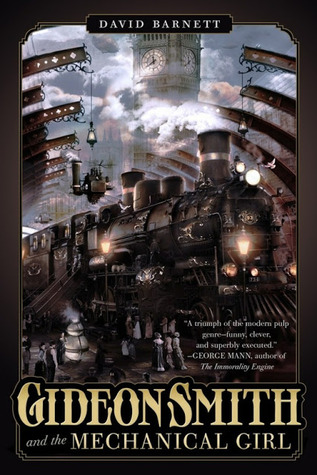Gideon Smith and the Mechanical Girl (2013, David Barnett) is a steampunk fantasy novel set in an alternate Victorian era, covering an intercontinental adventure to uncover the reason behind mysterious monster attacks plaguing England. It has its flaws, but it’s a solid page-turner that you can easily envisage as a big budget blockbuster. I’m also a sucker for airships, which helps a lot. There’s light spoilers incoming, so beware!
The story apes that of the typical pulp fantasy stories in the vein of Indiana Jones or Flash Gordon. Small-town boy gets in over his head in a grand adventure, collecting allies and an ancient magical artefact along the way. Of course, Egypt is involved.
It’s not the most unique tale, but the novel makes up for it with a colourful — if unevenly developed — cast of characters and an engrossing world that combines elements of reality with classic fiction. Expect cameos and allusions to many Victorian-era heroes and authors (fictional and otherwise), such as Inspector Lestrade and Lovecraft.
There are some playful jabs at today’s London and the English colonial attitude of old. For instance, Shoreditch in the novel is home to a nest of vampires. This mirrors Shoreditch’s role in the city today as one of London’s most vibrant nightclub scenes, with the clubbers taking up the role as the denizens of the night. We also find out that Queen Victoria is having the Taj Mahal moved brick-by-brick to London, because why not? It’s hers, after all.
Because of all the borrowing and tweaking, the world feels like a pastiche of every other story set in the era. But somehow the author makes it work. It’s equal parts bleak and intriguing, with the steampunk-mainstay airships — dirigibles being the preferred term in the novel — filling the skies above while peasants live their almost typical Victorian lives in the slums below.
There’s a few issues with some of the cast. The main problem is that some of the characters don’t seem to have any?
I’m not sure if it was intentional that the eponymous mechanical girl, Maria, has all the personality of a lump of plastic, and the autonomy of one to boot. She spends the whole book alternating between angst-ing and being kidnapped. The former is understandable given her lot, the latter borders on farce. Amazingly, she somehow doesn’t end up tied to a set of train tracks with a moustache-twirling villain gloating over her at any point in the story.
The titular Gideon’s character flip-flops between Nathan Drake and country yokel almost constantly, with some late-game cowardice thrown in later on that is almost immediately overcome in the name of plot. He’s a passable hero, when he’s not in ‘am I really going to be able to cope with all this adventure’ mode. Spoiler: This book has similarly titled sequels, so you already know he’s going to do quite well at this adventuring lark. He doesn’t have much of a personality to start with, but it does develop a bit over the course of the novel.
Bram Stoker and Elizabeth are awesome as a duo. Oh yeah, Bram Stoker is in this novel. Yeah, that Bram Stoker. I really liked their whole dynamic, and their part of the story comes to an inevitable, yet very satisfying conclusion. The fact Bram Stoker is in the book at all was a pretty big what. I thought his appearance was going to be a passing cameo (not an uncommon event in this world), but the author really ran with the character in a way that was just the right level of ridiculous.
There are a number of other characters who can be boiled down to two word descriptions: Sweary journalist, sexy mechanic, submarine owner. Only Gideon and Bram seem to go through any real development, but given the length of the book I guess you couldn’t fully flesh out every single member of the crew. There’s always the sequels, right?
The book gets a little bit too ‘sexy’ at times, bordering on pure fanservice. Random mentions of erections and nocturnal emissions aside, pretty much every main woman in the novel ends up sans clothes at some point. Maybe this is another throwback to the old days of pulp heroes, but it feels odd to be reading such blatant pandering in an otherwise sexless novel. Also, what’s up with the guy whose every other word is the f-word?
Anyway, in spite of its flaws, I really enjoyed the book. It’s a fantastic introduction to the author’s alternate streampunk history, and I can see myself buying the next in the series just to see what other historical and fictional characters show up. It also helps the purchase that the first novel ends on a semi-cliffhanger, but don’t worry: The book tells a complete, compelling story, from humble beginnings to the final epic confrontation. If you’re into the whole aesthetic and pulp fiction genre, give it a go!
– Matthew







